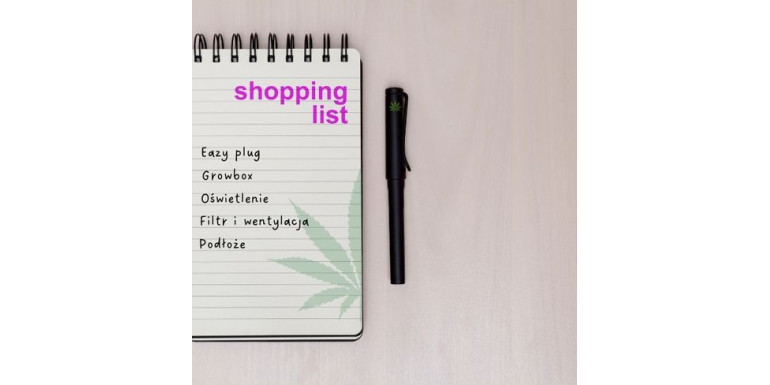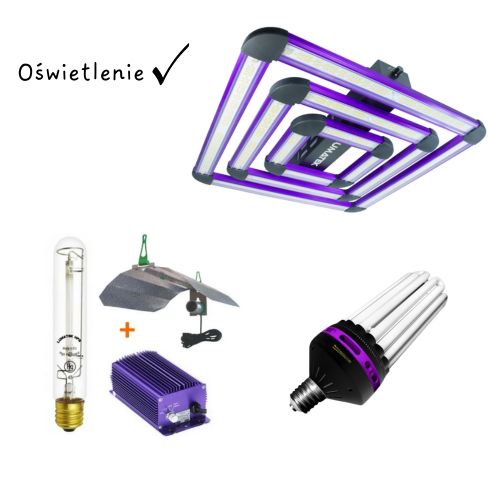
What to buy if I start growing indoors?
What to save myself and what not to forget?
Remember, it is illegal to grow cannabis (or industrial hemp without a permit in Poland)! We advise against breaking the Polish law.
1. Seeds and something to germinate.

REMEMBER THAT BEFORE YOU START GERMINATING, YOU MUST HAVE ALREADY PREPARED EQUIPMENT IE: TENT, POTTING LAMP AND SOIL, EXHAUST FAN! THIS IS THE BASIC RULE!
The basis and the first thing you acquire is, of course, the seeds or tent because it determines the intended size of the crop. In this guide, however, let's assume that you start with seeds, if you live in Poland the choice of vegetable seeds suitable for cultivation is large, or you can grow industrial hemp if you get the appropriate permit. If you live in Germany or Spain, for example, you can take advantage of the gifts of the law there and grow even cannabis! In that case, choose whichever variety seems most suitable for your needs, for example, using one of the most popular cannabis seed stores in Poland - MegaNasiona.pl.
Then once you have the seeds no matter what plant, you need to use something to germinate. The best way to germinate and the greatest germinability is provided by EAZY PLUG trays. Of all that we have learned over the years ways to germinate and media. This method is the safest and most effective, the simplest and the least risk of damaging something. It is ideal for beginners as well as commercial and advanced growers. Eazy plug trays come in sizes 6, 12, 24, 77, 150.
The tray contains compressed coconut, which does not disintegrate, does not absorb too much water, is "clean"- so it does not rot like other germination media, e.g. from excess water, is very easy to pull out, provides the highest germination rate, is simple and very quick to use.
How to germinate seeds?

Put the tray under a small stream of tap water and soak each cube thoroughly evenly, repeat the process 2-3 times so that the water thoroughly soaks into each cube. We put the seed in the hole of the eazy plug cube for any matching tray, which is there at the factory, and push with a finger or, for example, with the tip of a pen slightly into the depth, enough that the whole seed is covered, it does not want to go further, and at the same time you can see it from above. The tray must not stand in water, it should stand in a neutral place, preferably not in the sun or under a lamp, so as not to cause too rapid drying.
Do you put the seeds in a glass of water before germination?
We advise against this method, it doesn't do anything, except that there is more poking and and and the shell may be softened, which can expose the seed to breakage when putting it in the cube.
How to speed up germination?
.jpg)
You can use a heated mat or heated propagator to speed up germination, in the case of the mat itself, it's good to have a small greenhouse to keep it moist and warm for a longer period of time. You can also use germination boosters like Levo Seed Excel or Plagron SeedBooster.
Seeds usually germinate in 24-48h. But this time can be as long as 6-7 days which is rare.
2. Growbox or in what to grow plants at home?

Growbox is otherwise known as a growing tent. That is, a small room, airtight providing everything that a plant and grower needs, i.e. holes and ventilation sleeves, lightweight and fast-folding structure, walls providing high light reflectivity, quick lock to open, peep-ventilation windows, airtightness against the escape of odor and light. The choice of sizes and companies is huge in our store, we have only selected and proven by us companies that are sure not to disappoint. In addition, it can be folded and unfolded indefinitely, ensuring discretion and convenience.
Sizes start from 35x35x80 to 600x600x300cm. The most popular sizes are those for 1-5 plants, that is, from 40x40x120 to 120x120x200.
3 What kind of lamp for lighting plants

There are a good number of different lamps on the market for lighting plants. Once the most popular was HPS- or sodium lamps, widely used, providing good growth and flowering. The downside of these lamps was relatively high energy consumption and high temperature. MH lamps also fall into this category - they run on the same power supplies, but are designed for growth, vegetation, clones or mothers.
The other popular growing lamp technology is CFLs - which are energy-efficient lamps with small wattages. Their biggest disadvantage was their extreme fragility, you could easily damage the lamp when inserting it into the reflector, or during daily work in the tent. In addition, they were suitable for small plants and a small amount and cost relatively much. Currently, they have been almost completely supplanted by LED lamps.
The most popular and best growing lamps today are LED LAMPS. Over the years, the technology used in these lamps has changed significantly, as well as, most importantly, prices have dropped significantly. The lamps are characterized by low energy consumption, the lowest heat release rate, they also provide a high quality crop and even slightly reduce the flowering time. We try to leave the largest possible selection of these lamps in our store. From the most expensive ones produced by well-known brands, to the cheapest ones that offer very good lamps, on high-quality chips at a much lower price. Some mischief-makers even say that the difference in price is just because you don't get a colorful box with the logo of the brand whose ads you see everywhere and the housing itself is simpler and cheaper, but the product works just as well.
Remember to buy pendants for the lamp, they make the work of lowering and raising the lamp much easier, and cost very little, and a mechanical or electronic timer to control the hours of operation of the lamp.
4. Air extractor and odor filter.
.jpg)
Air exhaust is a must, it ensures the removal of warm moist air and the supply of fresh air. Without it, there is no way for plants to grow healthily. Air also can not circulate in a small sealed room such as a garage- plants will rot. You need to properly select a fan for the area and power and type of lamp and the room where the tent will be located. Odor filter ensures that 90-99% of the smell of the crop for the human nose is neutralized and undetectable. For example, a 60x60x160 tent, a 150W LED lamp - a suitable extractor is between 120-200m3/h, to which a filter of the same or minimally higher capacity. All this is connected by aluminum cable - preferably soft and well use clip-on clips instead of tape. We are sure that it will not peel off.
5 What kind of soil for home growing?
.jpg)
Here the matter is quite simple, as long as not any from the market and as long as not from the backyard. Why not from the backyard? Because it contains a mass of creatures, weeds, fungi, bacteria, and you don't know what else, you may end up growing insects instead of plants. Why not just anything from the market? Because it's often a lottery, sometimes it won't be much different from the one dug from the garden, and sometimes you don't know quite why the plants can stop growing, or even fungi can appear, and the plants also stop. We strongly advise the use of professional adapted clean soil for specific plants like Plagron lightmix, batmix, canna terra proffesional or biobizz allmix. We always advise the LIGHTMIX version, the less fertilized the better because you can control the level of fertilization yourself and you know much better in which pot how much nutrients I find, and with additionally fertilized allmixes, etc. it is a bit of a lottery.
Is it worth growing in a coconut for the first time?
In our opinion, it's NOT WORTH IT, coconut often leads to a slow start, and at first the plants can look very bad, which inexperienced grower can panic and will only make mistakes that will lower his yield or kill the plants. If you already like to experiment then it's best to get a soil/coconut mix such as 50/50.
Is it worth growing in hydro for the first time?
Not worth it, jumping pH, root diseases, can become a big problem for an inexperienced grower. Leave coconut and hydro for the second in the life of the plant cycle.
Is it worth using AirPots?
In our opinion, for fast-growing greens and single-season plants, it is completely not worth it. Watering requires much more time, it is also needed more often, the benefits are not visible any
What is better fabric pot or plastic pot?
Both have their pros and cons. Both work very well. Material ones, in our opinion, give a slightly better possibility, for example, to adapt to uneven ground, the roots have better access to air, so it is not easy to lead such to rot, they are collapsible and take up less space, they do not damage easily. If you decide to go for fabric pots, try to find those made of thicker material- they are easier to water!
What size pot for an automaton or manual?
Automatics are fast-flowering green plants such as cherry tomatoes and manuals are light-dependent plants such as peppers. :) For automatics 10L-18L in our opinion, smaller pots unfortunately reflect significantly on the yield and quality. For manual it's 10L-56L, it depends on how much space you want to fill with one plant and how long growing season you are planning
6 What fertilizers to use for indoor growing.
The choice of fertilizers is huge, the basic division is mineral and bio. When it comes to mineral fertilizers, we believe that they allow you to extract the most potential from the plant, but they also need to be used carefully. The basic set for a beginner, which will ensure good growth and flowering at the same time with the least risk of overfertilization, will be a set consisting of the highest quality fertilizers Advanced Nutrients: Grow, Micro, Bloom, and Atami Bloombastic for flowering. When it comes to Bio, for example, we always recommend the proven Biobizz brand fertilizers ie: BioGrow, BioBloom, TopMax, Alg-a-Mic, Bio Heaven, Root Juice. There are still a lot of additives on the market even from the mentioned companies, but for the first time the listed ones are completely sufficient to ensure a high-quality decent crop.
8. other useful accessories on the crop
- Horticultural wire - it works for everything from holding the filter to catching the cable to the tube and holding the plant when training or after damage.
- weather station - a must-have to monitor temperature and humidity
- scissors for plants
- Co2 e.g. smart bag or boost buddy
- Mixing fan
9. what is not needed for the first cultivation
- Humidifier
By far the most important of the unnecessary things is a humidifier. With ordinary cultivation - without mothers and clones it DOES NOTHING, except that the pot evaporates more slowly, thus increasing the chance of root rot.
- CO2 tablets don't work, they turn into carboxylic acid in the water and lower the pH, nothing more. They work well in aquariums ;)
- SupertThrive - has rather bad reviews, despite the great hype once. The same is true of too many additives
- Injection fans - only cause a lack of vacuum in the tent and can lead to unwanted odor coming out of the tent.
- Training elbows- in the first cultivation there is no need to train, learn the plants, devise a plan and think about what training would have a purpose. For the first time there is not much point.
- ph meter and ec meter- if you are using Advanced Nutrients, phMeter will not be needed, the fertilizers will do everything for you. Use 1/2 or 3/4 of the recommended dose and the EC meter won't be needed either
- Ph Down - a pH lowering agent, remember that it is a highly concentrated fertilizer - acid mostly phosphoric 59% is 10x as much as in the basic flowering nutrient. It strongly raises EC, be very careful. If you use Advanced Nutrients you won't need it, and if you don't use fertilizers from Advanced Nutrients then get ph down organic.
.jpeg)

